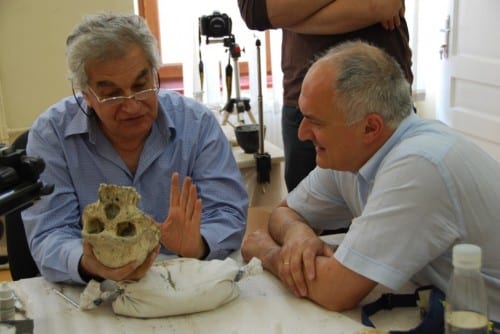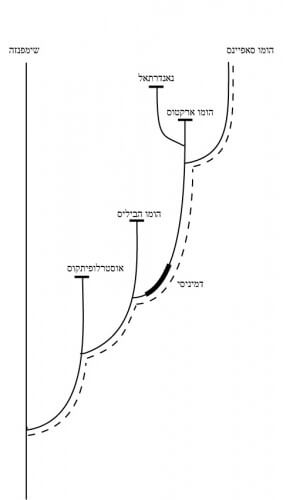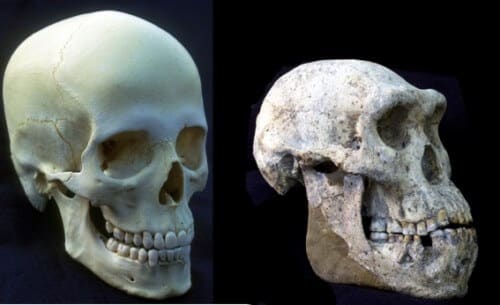An international team of researchers with the participation of Prof. Yoel Rek from Tel Aviv University revealed the dramatic discovery

A historic discovery in Georgia: an international team of researchers has uncovered a complete skull that is the earliest evidence of human presence outside of the African continent. The remarkably complete skull, found along with bone species and skull fragments of four other hominids (the species included in the biological human family), is that of a new species of man known as Homo Georgicus. The dramatic scientific discovery was published last night in the journal SCIENCE.
"The skull, which was found together with the lower jaw, shows a significant disproportion between the large and prominent jaws and the volume of the cerebellum - a combination that gives it a very primitive and ape-like appearance," says the member of the international team studying the skull, Prof. Yoel Reck from the Department of Anatomy at the Tel Aviv University School of Medicine and a member of the Israeli Academy of Sciences. "The volume of the brain in the skull is 540 cc, a little over a third of the volume of our brain. It is a brain so small that this skull simply has no forehead - which contributes even more to its ape-like appearance."
More on the same topic on the science website:
- A stranger in a strange land / Kate Wong
- The skull in Georgia: a head is always a beginning
- The chimpanzee is allowed from the human
- Scientists have reconstructed the tree of human and ape evolution over the past 15 million years
- The evolutionary future of humanity
Prof. Rek was invited in 2011 to join the international team studying the skull from the excavation site in the village of Demanisi in Georgia. The excavation, which began in the XNUMXs as an excavation of a medieval village, has become over the years one of the most fruitful and significant excavations in the world. The nature of the excavation at the site suddenly changed when, completely by chance, large fossils of extinct animals were found under the cobblestones of the ancient buildings in the village of Demanisi - and later also human bones. Finding the complete skull is the expedition's crowning achievement.

The man, known as Homo Georgicus, lived 1.8 million years ago - and some members of the team consider him a subhuman of the species Homo erectus. "Currently in the textbooks, the story of human evolution is as follows: Australopithecines, (of which the famous Lucy is one of their kind), split from chimpanzees, Homo habilis split from Australopithecus, Homo erectus from Homo habilis and Homo sapiens, we, split from Homo erectus," explains Prof. Rec. "The textbooks also say that Homo Eractus was the first to come out of Africa 2 million years ago. But here in Georgia we discovered a group of hominids that are halfway between Homo habilis and Homo erectus - and we discovered them outside of Africa. This is the first exodus from Africa known to us, and one of many that followed. The last exodus from Africa, of course, was ours, Homo sapiens."
The complete skull excavated at the site is that of a very old man, with a solid and strong body structure, who stood approximately sixty-five meters tall. Beside him were found the remains of another elderly man, older than him, and of three other hominids, apparently of the same species. Prof. Rok believes that this indicates a mutual guarantee within the group, since the two elderly people were also injured - and would certainly need the support of their friends.

"There are many examples of side branches of hominid development - side branches from our point of view as Homo sapiens, of course - branches like Homo Neanderthalensis. What we have here with the new skull from Georgia is a completely different story. In terms of the evolutionary chain leading to us, this is an ideal link - it is not an exception and it is not a side branch. These are our real ancestors."

19 תגובות
The preoccupation with whether the Neanderthals and the Spigens are different or the same species is simply a joke. There is really no such thing as species, this is entirely an invention of taxonomists to sort the animals in a discrete manner. In any case, according to genetic evidence, there was cross-racial fertilization, but it was very weak, so it can be said that the Neanderthals and the Sapiens were very different from each other and probably had different cognitive abilities.
What makes you think or be sure that man evolved from a primitive creature?
After all, it has never been proven that there is a connecting factor between the entire list of human-like findings, and the human (us).
The structural relationship that reminds us of the human structure, the close genetic resemblance, and the production of tools, still cannot prove that this is a development from another production to man as we are today. What else has not been proven that a certain species can turn into another species, apart from stories and legends.
Benjamin May
Thanks for reply,
Laurie
The answer is simple, in most cases there is no other way to evaluate
intelligence level. Also in this case, because of the differences
In the shape of the skull and the size of the parts inside it (as stated in
The Neadrtal visual area was emphasized compared to the areas
the cognitive ones with us), it is quite certain that the Neanderthals were not
Has a higher intelligence than ours but there is no way to prove
This is an absolute certainty, unless you rely on stone tools they made
Compared to those created by the Homo sapiens.
Father, is it possible to receive a notification by email about a comment related to the article I responded to.
Benjamin May
If it is a fact, that the size of the brain alone does not indicate the level of intelligence, but only relates its size to the size of the body,
It is not clear to me why they continue to use only the size of the brain to determine the level of intelligence. .
To my father
So why do Africans not have these genes? And if so, why name it?
Those "Neanderthal genes"? After all, it is clear that part of the human genome is shared.
For both sexes (I think, the varieties); Or the geneticists were negligent, or
that the spicans the spicans mated with the neanderthals. I don't understand how
A third explanation is possible.
And I actually heard a different explanation except for the Neanderthal genes that we all carry - that they were left over from the common father 600 thousand years ago.
Get published last night - I laughed.
safkan
It is not a hypothesis "that the Spines and the Neanderthals could have interbred with each other
and give birth to fertile offspring" is a fact proven by genetic tests. That's why we are talking
In two varieties that apparently grew from "Homo Heidelbergensis" or species
It seems that in any case from the very closeness and definition it is Homo sapiens.
To the best of my recollection, the body mass of the Neanderthal was smaller than
The modern man, but his mind was structured differently.
In the Neanderthal's brain was the occipital lobe
(responsible for visual functions) is larger and the associated frontal lobe
For cognitive functions (language, attention, memory, motivation, executive functions
and more) is smaller than in modern man.
Benjamin May.
The differences in brain volume between the Neanderthals and the Sapiens are smaller than you stated. More important is the ratio between the size of the brain and the body mass, if it is preserved the size of the brain has no meaning since it is possible to have the same amount of brain cells.
According to my memory, in the Hebrew Wikipedia there is an explanation why the brain volume of the Spines Spines today is only 1350: a partial explanation for this is that the Mongolian race has a very small body mass relative to the Caucasian and Negroid races, therefore their brains are smaller and this is what lowers the average.
Also, if we look at dogs, it seems that there is a very large flexibility of body volume without it particularly affecting intelligence.
That's why I don't think it's possible to measure the development of intelligence by brain size. A better measure would include the means of living that a species can build. Spines Spines had the most sophisticated tools about 50 thousand years ago.
incidentally. According to today's information - probably the Spines and the Neanderthals could breed with each other and give birth to fertile offspring. Therefore, there is a hypothesis that actually all the Spines are only one species, while the Spines and the Neanderthals are two varieties of the same species.
Lasaf: You were right.
I just worked hard.. 😉 The drawing of the roots in the article is simply wrong and should be replaced.
In the chapter "Origins of the Neadrats" in the entry "Neadratlian Man" in Wikipedia it is written:
"...from a progenitor population of ancient humans classified by
Different researchers like "pre-Neanderthals", "archaic Homo sapiens"... and are characterized by a brain
with a volume of 1,100 to 1,300 cc, significantly larger than Homo erectus fossils, but
Still lower than the average of "classic" Neanderthals and modern humans. These fossils
Also very similar to the classic Neanderthals in many archaic features, such as brow ridges
Developed, lack of chin protrusion...
Lassaf: It makes sense that the Neanderthal did not come out of Homo erectus
but from an ancient Homo sapiens and therefore belongs to the species Homo sapiens. Because
According to my understanding, the increase in brain volume was supposed to be gradual.
For the largest brain yet identified as Homo erectus (according to the data
that I found) had a volume of 1050 cc.
The averages I found for the Spians are 1350 cc
And Niadertal 1620 cc and a jump of almost 60
Percentage of the size of any organ (between the erectus
Leniadertal), just doesn't seem reasonable to me
- As a person who advocates the principles of evolution...
But one of the most prominent things (literally..)
What distinguishes the Homo sapiens is the chin - and I don't
It is certain whether or not the early Homo sapiens had a chin
- And if there was, why didn't he move to Niedertal.
In addition to the fact that there was an "early departure from Africa",
The researchers claim a new claim that provokes disagreement and debate that:
"Remains of those who until today were considered three separate species -
(which were discovered on the same site),
Homo habilis, Homo rudolfensis and Homo erectus,
They are one species in the same population in which structural (morphological) changes appear,"
Following this, the researchers claim that it may be necessary to change the sorting
and group the three species into one - Homo erectus,
A union that changes the structure of the "family tree" of the genus Homo,
"Homo Florensus" is probably a subspecies (of Arctus) that shows
the "dwarf phenomenon" that is known to threaten other animal species,
As for Daniel's response...
It is hoped that the readers of the site are not ignorant
They are planted in unknown beings (such as God),
What about homoflorensus?
God will save you from this nonsense
Just don't burn your whole life looking for something gay
And in the end they will find out (for sure) that you were living in a movie the whole life
is not that a loss?
Further (and as an addendum) to Benjamin's response:
More and more researchers conclude that the "Spines" are the same species as the "Neanderthals",
and classify the two as two subspecies of the same species - Spines,
Drawing the split of the races shows a partial picture and subtracts
Important facts for discussion:
The species we belong to is called Homo sapiens.
He was apparently preceded by a species called "Homo sapiens idelto".
The species "Neanderthal man" was created outside the borders of Africa
Therefore, one cannot find his genes (however few they may be)
but in human races that evolved outside
to this continent. for the reunion, as well
There is no hint of a split in the Homo sapiens species in the painting.
It is interesting to note that the species "Neanderthal man" had a blacksmith
Significantly larger brain than Homo sapiens.